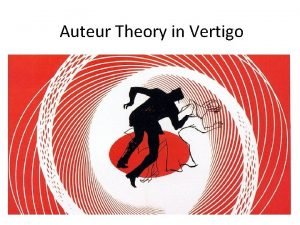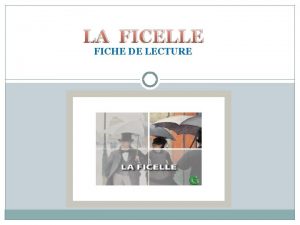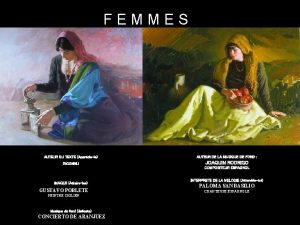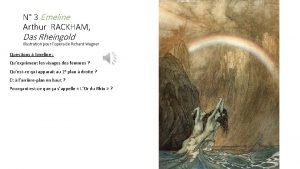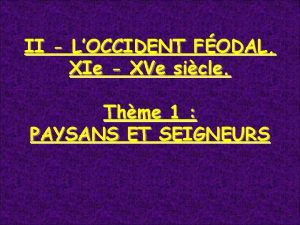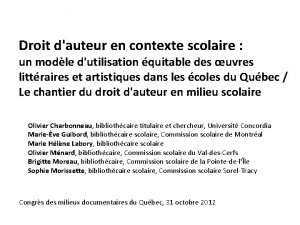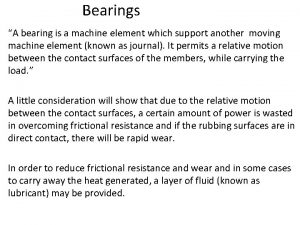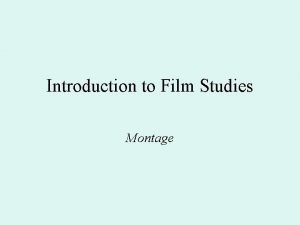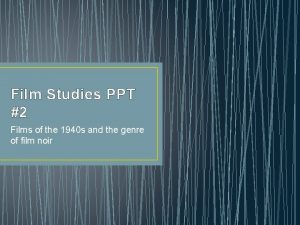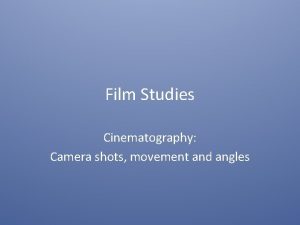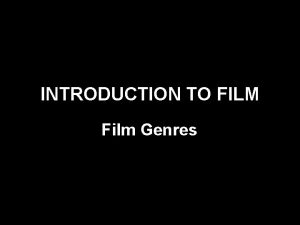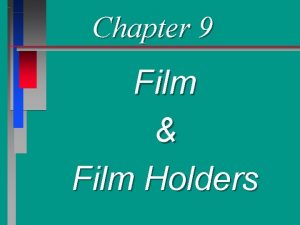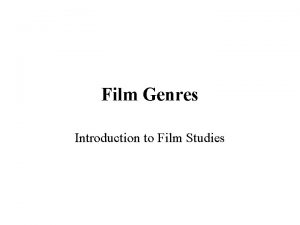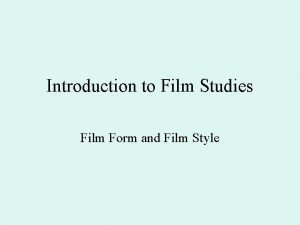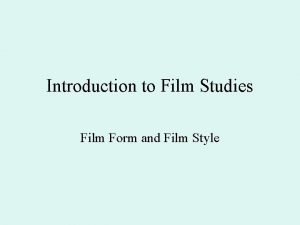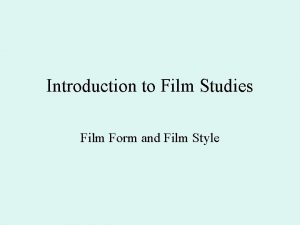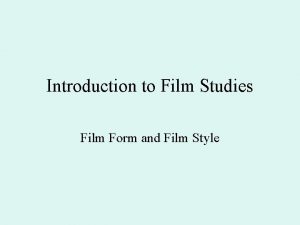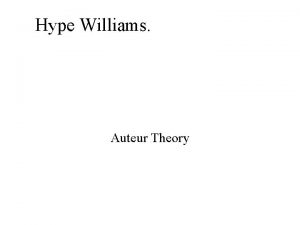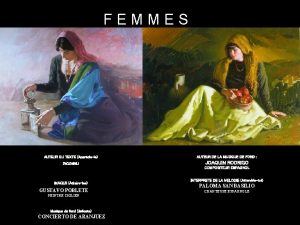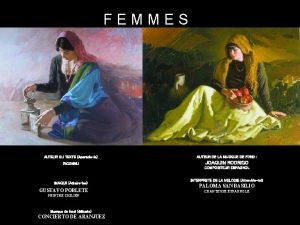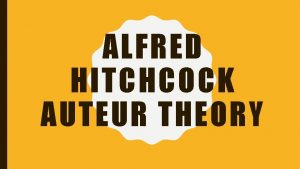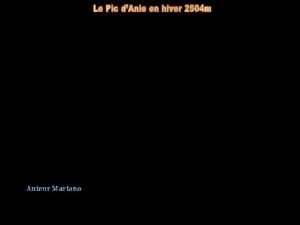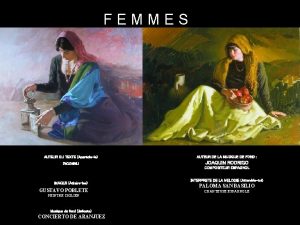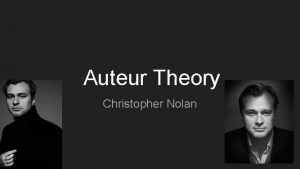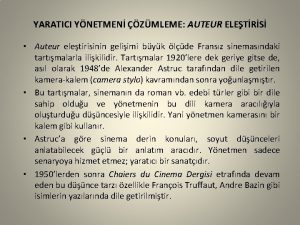Auteur Study Unit 11 Film studies Unit 3

























- Slides: 25

Auteur Study Unit 11: Film studies Unit 3: Research Techniques Auteur Assignment number 2 Lecturer: Faustina Starett

For this assignment we are to complete 5 tasks. 1) Propose an area of research 2) Investigate ‘Auteur Theory’, a director strongly related to ‘Auteur Theory’ and their development in Film Form 3) Demonstrate understanding of ‘Auteur Theory’ and related theories 4) Show understanding of cinematic narratives 5) Present research.

Area of Research My area of research into ‘Auteur Theory’ is based around the director David Lynch. This man directed several major films and a few TV serials. His most notable films are “Eraserhead”, “Dune” and “Blue Velvet”. His most notable TV serials are “On the Air” and “Twin Peaks”

Auteur Theory Before researching a director I must first ask the question, “What is Auteur Theory? ” Collins Dictionary gives this answer, “The [Auteur] theory holds that a single film or an entire body of work by a director (or less commonly, a Producer) reflects the personal vision and preoccupations of that director, as if he/she were the works primary “author” (auteur)”

The Auteur Theory has its origins in a 1948 article by Alexandre Astruc in the film magazine Cahiers du Cinema. However this article sparked much criticism, such as the fact that any production, no matter how small, is a collaborative effort, and to raise the director as the sole role of importance, was to belittle to contribution of those serving other key roles, such as the cinematographer, actors etc.

This first argument is countered by crediting the director with the choice of their crew and therefore the director is choosing a support crew that will help with their own creativity. However this is not always the case as it is normally the producer who chooses the cast and crew, this is known to cause tension between director and producer as one can interfere with the others creative values and vision.

In 1962 Andrew Sarris published “Notes on the Auteur Theory in 1962”. In these he demanded a more detailed explanation of auteur theory. He proposed the three premise on how to spot an auteur. The first is “the technical competence of a director as a criterion of value”. He is most notated for saying that “a great director must at least be a good director”.

The second premise is “the distinguishable personality of the director as a criterion of value. … a director must exhibit certain … characteristics of style, which serve as his signature. ” This point brings us back to the question originally asked “What is auteur theory? ” Also this point most blatantly shows us what the core of Auteur theory is.

The third and last point brought up is the interior meaning of a film. “Interior meaning is extrapolated from the tension between a directors personality and his material. This conception of interior meaning comes close to what Astruc defines as mise-en-scene, but not quite. ” This premise is vaguely ambiguous and ineffable. It is a combination of this and the second point that is referred to as “Lynchian”

David Lynch, Auteurist David Lynch hs been most notably referred to as “if not one of the greatest Auteurists then at least one of the most original”. His most recurrent themes are having his films based in small town USA locations, low/middle frequency noise, Dark and rotting environments, distorted characters, Polarization of characters (e. g. Madonna's vs. Whores), physical damage to the skull or brain, dreams to connect the plot and close up shots of eyes.

A time-line of Lynch’s work will help us understand how he became one of the most notable of Auteur’s, however it is important to note that David originally trained to be an artist after studying in Philadelphia, and then travelling to Europe for a planned visit of 3 years, of which he spent 15 days.

Short Films Six Men Getting The Grandmother Sick 1970 1967 The Alphabet 1968 The Amputee 1974 The Cowboy and the Frenchman 1989 Premonitions Following an Evil Deed 1996 Industrial Symphony No. 1 1989

Feature Length Films Eraserhead 1977 Lost Highway Mullholland Drive 2001 Dune 1984 Wild at Heart 1990 1997 The Elephant Man 1980 Blue Velvet 1986 Twin Peaks: Fire The Straight Story 1999 walk with me 1992

David Lynch spent 5 years on pre-production work for Eraserhead. Amazingly however, it has only 20 pages of script. When asked in an interview what he thought of his film, he replied with “[Eraserhead] is my perfect film”. Indeed, through out his later works, (most notably “Dune” and “Blue Velvet”). We see themes which bring us back to Eraserhead.

Lynch’s Recurring Themes I shall use the films “Dune” and “Eraserhead” as examples of Auteurism in his films. At the beginning of Eraserhead we see a worm emerging from Henrys mouth, Dune shows large phallic worms. In Eraserhead Henrys worm is drowned as is the case in Dune. At the beginning of Eraserhead Henry is submerged in a dream sequence as is Paul in Dune.

Eraserhead and Dune introduce the two main recurrent themes of Lynch’s work (the auteur). Firstly there is the plot being linked by dream sequences of the two main characters. Secondly there is the obsession with biology. In Eraserhead the worms resemble both sperm and umbilical cords. In Dune, worms are one of the biggest threats posed to Paul, being large in size and trying to kill him, however he masters the threat.

Lynchian Style and Various Themes David Lynch relates to various other themes such as realism and surrealism mixing together during his films, he is noted for saying “life isn't un-complicated … why should films be? ” such is his attitude that it takes several viewings of his films so that they can be understood.

Lynch and Surrealism He relates surrealism in Eraserhead with Death hiding behind his radiator, Henry sleeping with the next door neighbour on a bed of milk, cutting the chicken wile it bleeds and squirms on the table. This can be seen that in Henrys world he is in complete control and that it has been created solely for him. This is also common during the dream sequences.

Lynch and Gender In many of his pieces his main character (especially in films) are male, with females being evil, Death is female, the seductress, the deranged wife and even to a certain extent the child featured in Eraserhead. Lynch also shows his male characters (in most productions) generally afraid of sex as it is shown to be either unsanitary or morbid.

During this presentation I have wrote about David Lynch as one of the most original Auteurists. I shall now show some screen shots of his work from the film Dune

From these images we can see Lynch’s recurring themes throughout his other films

Websites Perhaps the best view I can give into David's work is in showing his self made website. http: //www. davidlynch. com.

As you can see the site itself is rather surreal and gives us a view of David's work. Another good website is www. thecityofabsuridity. com which is a fan run site and documents his life and works.

Bibliography The films of David Lynch – John Alexander David Lynch – Michel Chion Czar of the Bizarre – Richard Corliss A cinema without walls – Timothy Corrigan The complete David Lynch – David Hughes Mr Contradiction – Chris Rodley Lynch on Lynch – Chris Rodley Weirdsville USA: the obsessive universe of David Lynch – Paul Woods Wikipedia – David Lynch, Auteur Theory www. thecityofabsuridity. com

I hope you have enjoyed my presentation on Auteur Theory and David Lynch. Further information and sources can be referenced in my written report
 Vertigo cameo
Vertigo cameo What is auteur
What is auteur Jackson film director
Jackson film director Le genre de l'oeuvre la ficelle
Le genre de l'oeuvre la ficelle A quoi sert cette chanson si elle est désarmée
A quoi sert cette chanson si elle est désarmée Texte auteur inconnu
Texte auteur inconnu Unizo wiki
Unizo wiki Quel est l'auteur
Quel est l'auteur Enluminure du cartulaire du couvent des billettes
Enluminure du cartulaire du couvent des billettes Syntra haalbaarheidsstudie
Syntra haalbaarheidsstudie Stratégie de distribution intensive
Stratégie de distribution intensive Auteur
Auteur Rien ne se perd rien ne se crée tout se transforme auteur
Rien ne se perd rien ne se crée tout se transforme auteur La structure du texte explicatif
La structure du texte explicatif What is auterism
What is auterism Auteur
Auteur Diagnostic strategique
Diagnostic strategique Droit d'auteur
Droit d'auteur Slipper or guide bearing
Slipper or guide bearing Wjec eduqas film studies for a level & as
Wjec eduqas film studies for a level & as Montage in film studies
Montage in film studies Ppt
Ppt Film studies terminology
Film studies terminology Vertical
Vertical A level film studies past papers
A level film studies past papers Paradigm shift from women studies to gender studies
Paradigm shift from women studies to gender studies
